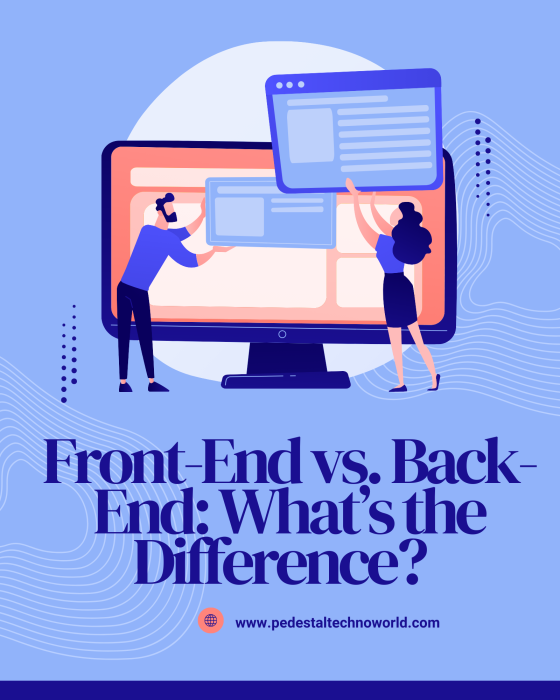Front-End vs. Back-End: What’s the Difference?

Posted by Seo Team Posted by Oct 03, 2024 in Skill development
When building websites or web applications, two essential components form the foundation: front-end and back-end development. Both parts work together to deliver a seamless user experience, but they serve distinct roles in web development. Whether you’re planning to start a career in web development or are just curious about how websites work, understanding the difference between front-end and back-end is vital. This blog will explain what each entails and how they come together to create the websites we use every day.
At Pedestal Techno World, we offer a Full Stack Developer course in Jaipur that teaches both front-end and back-end skills, allowing students to become proficient in all areas of web development. In this blog, we’ll delve into the details of front-end and back-end development, their key technologies, skills required, and how full-stack developers handle both sides.
What is Front-End Development?
Front-end development focuses on what users see and interact with on a website. It is often called "client-side" development because it deals with the interface that users interact with directly on their browsers. The main goal of front-end development is to ensure that the website looks visually appealing, is easy to navigate, and works smoothly on different devices.
Core Front-End Technologies:
HTML (HyperText Markup Language): HTML forms the structure of a webpage. It is used to define headings, paragraphs, images, links, and other essential elements that make up the page layout.
CSS (Cascading Style Sheets): CSS is responsible for the styling of the webpage. It controls how HTML elements look, including colors, fonts, spacing, and layout. CSS allows developers to create responsive designs, ensuring that websites look great on all devices, from desktops to mobile phones.
JavaScript: JavaScript adds interactivity to the website. It enables dynamic features like dropdown menus, image sliders, pop-ups, and interactive forms. JavaScript also allows developers to make websites more engaging and user-friendly.
Example of Front-End Development:
Imagine you’re visiting an e-commerce website to buy a product. The product listings, navigation bar, search bar, and "Add to Cart" buttons are all part of the front-end. A front-end developer ensures that these elements are well-designed, function properly, and provide an excellent user experience. They are also responsible for ensuring that the website works across different browsers and devices.
Skills Required for Front-End Developers:
Design and User Experience (UX): Front-end developers must have a good eye for design and an understanding of user experience principles. They work closely with designers to ensure that the website is visually appealing and easy to use.
Problem-Solving: Front-end developers encounter challenges like ensuring compatibility across different browsers and devices. They must find solutions to optimize performance and ensure that websites load quickly.
Attention to Detail: Small design elements, like spacing, alignment, and colors, can make a big difference in how a website looks and feels. Front-end developers need to pay attention to every detail to ensure a polished final product.
What is Back-End Development?
Back-end development, on the other hand, focuses on how the website works behind the scenes. It is often referred to as "server-side" development because it involves managing the server, database, and application logic. While users do not directly see or interact with the back-end, it is crucial for making the website functional.
Core Back-End Technologies:
Server: The server hosts the website’s data and content. It processes user requests, retrieves the necessary information from the database, and delivers it back to the user’s browser.
Database: Databases store and organize information, such as user profiles, product listings, and transaction details. Common databases include MySQL, MongoDB, and PostgreSQL. A back-end developer ensures that the database is structured efficiently to retrieve and store data quickly and securely.
Programming Languages: Back-end developers use languages like Python, Ruby, PHP, and Node.js to build the logic and functionality that powers the website. These languages are used to write server-side scripts that handle data processing, authentication, and server responses.
Example of Back-End Development:
Returning to the e-commerce website example, when a user clicks on a product to view details or makes a purchase, the back-end processes that request. It retrieves the relevant product information from the database, updates the shopping cart, and handles the payment process securely. The back-end ensures that everything functions smoothly and that sensitive data, like credit card information, is protected.
Skills Required for Back-End Developers:
Logical Thinking: Back-end development requires a solid understanding of logic and algorithms. Developers must create efficient code to process requests and manage data.
Security: Back-end developers are responsible for implementing security measures, such as encryption and authentication, to protect user data and prevent unauthorized access.
Database Management: Back-end developers must know how to structure, query, and optimize databases to handle large amounts of data efficiently.
Key Differences Between Front-End and Back-End Development
1. Focus:
Front-End: Deals with the visual elements and user interaction.
Back-End: Focuses on the functionality, databases, and server-side logic.
2. Technologies Used:
Front-End: Uses HTML, CSS, and JavaScript to build the website’s interface.
Back-End: Uses server-side languages like Python, Ruby, PHP, and databases like MySQL or MongoDB.
3. Skills Needed:
Front-End: Requires design skills and attention to detail to create a visually appealing and responsive interface.
Back-End: Requires logical thinking and security awareness to ensure the website works efficiently and securely.
4. User Interaction:
Front-End: Directly interacts with users, ensuring they have a smooth experience while browsing the site.
Back-End: Works behind the scenes, processing requests, handling data, and ensuring the website functions correctly.
Benefits of Being a Full-Stack Developer:
Versatility: Full-stack developers can work on both the front-end and back-end, giving them the ability to create complete web applications.
Higher Job Opportunities: Full-stack developers are highly sought after by companies, as they can handle multiple tasks and contribute to various stages of development.
Better Understanding of Web Development: Learning both front-end and back-end helps you understand how the entire web development process works, making you a more well-rounded developer.
Conclusion
Both front-end and back-end development are crucial components of building functional and visually appealing websites. Front-end developers focus on what users see and interact with, while back-end developers handle the server-side logic and databases that make everything work behind the scenes. Understanding the difference between these two roles is essential for anyone looking to pursue a career in web development.
If you're ready to start your journey in web development, consider enrolling in our Full Stack Developer course in Jaipur at Pedestal Techno World. You'll learn the skills you need to build complete web applications, from designing beautiful interfaces to managing complex databases. Whether you want to focus on front-end, back-end, or both, our course provides the training you need to succeed in the world of web development.

